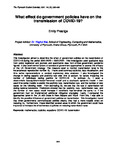What effect do government policies have on the transmission of COVID-19?
| dc.contributor.author | Prestige, E. | |
| dc.date.accessioned | 2021-12-24T17:41:25Z | |
| dc.date.available | 2021-12-24T17:41:25Z | |
| dc.date.issued | 2021 | |
| dc.identifier.citation |
Prestige, E. (2021) 'What effect do government policies have on the transmission of COVID-19?', The Plymouth Student Scientist, 14(2), pp. 356-428. | en_US |
| dc.identifier.uri | http://hdl.handle.net/10026.1/18509 | |
| dc.description.abstract |
This investigation aimed to determine the effect of government policies on the transmission of COVID-19 during the period 30/01/2020 – 03/01/2021. This investigation used qualitative data from policy legislation and journals and quantitative data from official government pandemic figures. It also used central factors of successful government approaches to assess the efficacy of the UK Government strategy. The measure used to monitor transmission rates is the instantaneous reproduction number Rt. I have used summary statistics, data visualisation, and time series representations to conduct exploratory data analyses. I also investigated the change in testing capacity and positivity rate over time to account for factors impacting the number of individuals testing positive for COVID-19. To estimate Rt, I used a deterministic Susceptible-Infected-Removed model and a stochastic epidemic model. I then used time series models to predict the positivity rate, transmission rate, and the number of new cases for the following week. From estimating Rt, we see that the rate of transmission fell during national lockdowns. Predictions showed that the positivity rate, transmission rate, and the number of new cases would increase if conditions had remained the same, i.e. if the government had not implemented additional mitigation strategies. Lastly, I compared the approaches taken in the UK with those in New Zealand and Brazil. From this, I was able to identify the possible influence of government policies on transmission. This investigation found that when governments communicated policies clearly, they had a more notable effect on reducing Rt. Furthermore, I have identified several areas in which the government could have improved to increase the effectiveness of policies on reducing transmission rates. | en_US |
| dc.language.iso | en | en_US |
| dc.publisher | University of Plymouth | en_US |
| dc.rights | Attribution 3.0 United States | * |
| dc.rights.uri | http://creativecommons.org/licenses/by/3.0/us/ | * |
| dc.subject | mathematics | en_US |
| dc.subject | statistics | en_US |
| dc.subject | equations | en_US |
| dc.subject | COVID-19 | en_US |
| dc.subject | transmission | en_US |
| dc.title | What effect do government policies have on the transmission of COVID-19? | en_US |
| dc.type | Article | en_US |
| plymouth.issue | 2 | |
| plymouth.volume | 14 | |
| plymouth.journal | The Plymouth Student Scientist |



